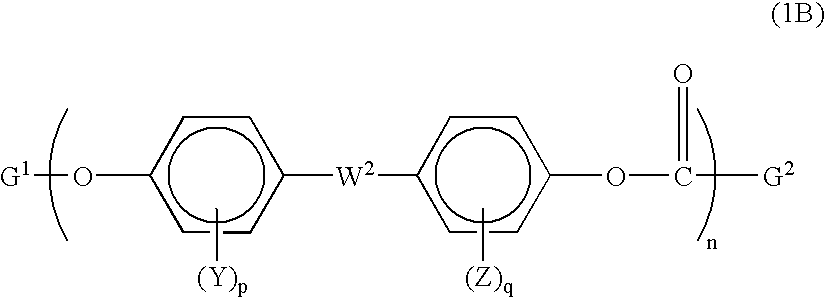Polycarbonate composition, write once read many optical disc substrate and write once read many optical disc using same and process for production of write once read many optical disc
a technology of polycarbonate and composition, applied in the field of polycarbonate composition, can solve the problems of discs attracting each other, difficult industrial handling, deterioration of the final quality of such a disc, etc., and achieves the effects of improving antistatic properties, good coloration, and good coating
- Summary
- Abstract
- Description
- Claims
- Application Information
AI Technical Summary
Benefits of technology
Problems solved by technology
Method used
Image
Examples
example 1
In a 20 l vertical agitated stainless steel reaction vessel equipped with a condenser were charged 2,283 g (10.0 mols) of bisphenol A, 2,290 g (10.7 mols) of diphenyl carbonate, and 0.7 ml (7×10−6 mols per mol of bisphenol A) of 0.01 N solution of sodium hydroxide as a catalyst. The air within the reaction vessel was then replaced by nitrogen. The mixture was then heated to a temperature of 220° C. for 40 minutes so that the monomer as staring material was melted. The mixture was then reacted at 220° C. and 1.33×104 Pa for 60 minutes, at 240° C. and 2.00×103 Pa for 60 minutes and then at 270° C. and 66.7 Pa for 60 minutes. After the termination of reaction, the reaction solution was then fed to a twin-screw extruder by a gear pump. Butyl p-toluenesulfonate was then added to the reaction solution as a catalyst deactivator (twice the molar amount of sodium hydroxide used as catalyst). Further, to the reaction solution were added 4-t-butylphenylphenoxy-terminated oligomer obtained by i...
example 2
A polycarbonate composition was obtained in the same manner as in Example 1 except that 4-t-butylphenylphenoxy-terminated oligomer (number-average number of repeating units (m): 3) as used in Example 1 was added in an amount of 1 part by weight based on 100 parts by weight of polycarbonate.
The viscosity-average molecular weight of the polycarbonate composition thus obtained, the proportion of alkylphenoxy group in oligomer, the content of oligomer and the total amount of oligomers having from 2 to 4 repeating units are set forth in Table 2 below. The polycarbonate composition was then used to prepare a write once read many optical disc in the same manner as in Example 1. The charged voltage and water droplet contact angle of the formed substrate (before being coated with coloring matter) and the coloring matter coating unevenness of the write once read many optical disc are set forth in Table 2.
example 3
A polycarbonate composition was obtained in the same manner as in Example 1 except that 4-t-butylphenylphenoxy-terminated oligomer (number-average number of repeating units (m): 3) as used in Example 1 was added in an amount of 5 parts by weight based on 100 parts by weight of polycarbonate.
The viscosity-average molecular weight of the polycarbonate composition thus obtained, the proportion of alkylphenoxy group in oligomer, the content of oligomer and the total amount of oligomers having from 2 to 4 repeating units are set forth in Table 2 below. The polycarbonate composition was then used to prepare a write once read many optical disc in the same manner as in Example 1. The charged voltage and water droplet contact angle of the formed substrate (before being coated with coloring matter) and the coloring matter coating unevenness of the write once read many optical disc are set forth in Table 2.
PUM
| Property | Measurement | Unit |
|---|---|---|
| weight | aaaaa | aaaaa |
| antistatic properties | aaaaa | aaaaa |
| mechanical properties | aaaaa | aaaaa |
Abstract
Description
Claims
Application Information
 Login to View More
Login to View More - R&D
- Intellectual Property
- Life Sciences
- Materials
- Tech Scout
- Unparalleled Data Quality
- Higher Quality Content
- 60% Fewer Hallucinations
Browse by: Latest US Patents, China's latest patents, Technical Efficacy Thesaurus, Application Domain, Technology Topic, Popular Technical Reports.
© 2025 PatSnap. All rights reserved.Legal|Privacy policy|Modern Slavery Act Transparency Statement|Sitemap|About US| Contact US: help@patsnap.com



